Wasps and bees are close relatives belonging to the same insect order of Hymenoptera along with ants. These unlikely cousins have many things in common. They both are black with yellow stripes. They both buzz around in the whirls of spring and summer. They both will sting you without thinking when they feel threatened. And yet, one of them is largely disliked by the public, whereas the other is highly appreciated.
But what about the nest? Do they build their nests in the same fashion?
Beehives and wasp nests are different. Bees build their hives in hollowed-out areas like a cavity in a tree trunk or even your mailbox, while wasps prefer to build on top of surfaces like a wooden beam. Their homes also differ in size, building material, and structure as well.
The presence of a nest or beehive tells you which species of the Hymenoptera you are dealing with.
Read on to find out more differences between the hive and the nest.
Wasp Nest Vs Bee Nest: Construction And Appearance
Wasp Nest
The wasp constructs its nest from wood pulp that it has chewed up. The queen builds the nest using chewed-up wood fiber scraped from nearby wood material. She mixes the wood fiber with her saliva, chewing it until it creates a form of paper pulp. She then spits it out and uses the pulp to build her nest.
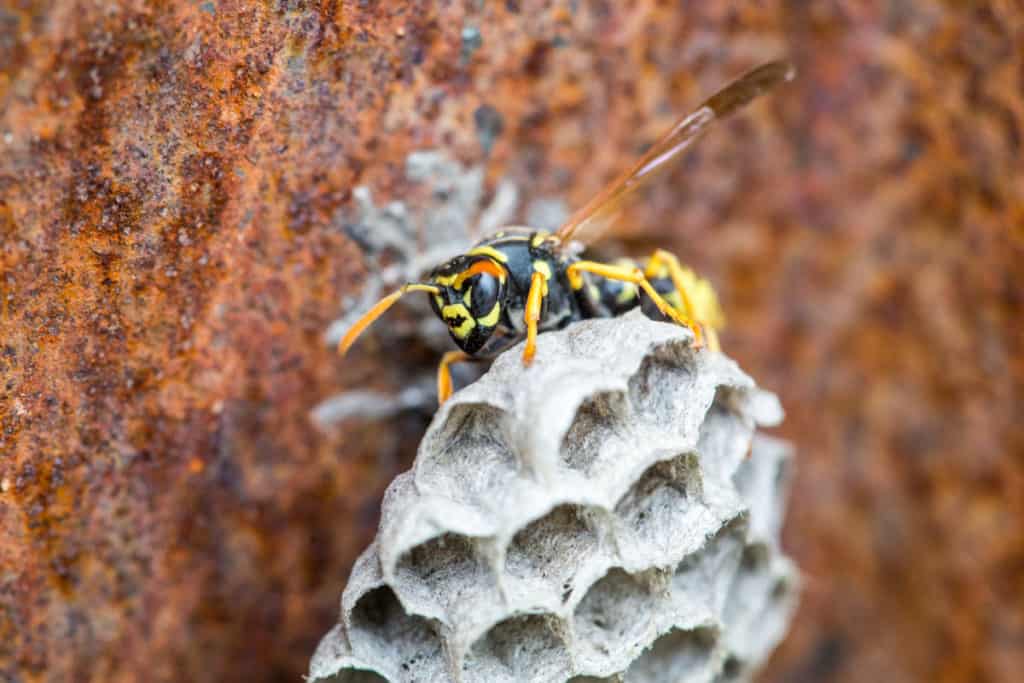
The nest looks papery grey with small, intricate, hexagonal cells on the outside that mirror small umbrellas placed next to each other. If the wasp chewed colored wood to make their nest, it will take on the hue of the wood. At close inspection, you will probably see the larvae inside the spaces in the nest. The wasp nest may have more than one entrance depending on the species.
Bee Nest (Beehive)
Instead of nests, bees build hives that are much more intricate as they hold more residents than the wasp’s nests. The beehive is constructed using beeswax which the bees chew until it becomes soft. They then use large quantities of the softened wax to bond the honeycomb cells to each other.
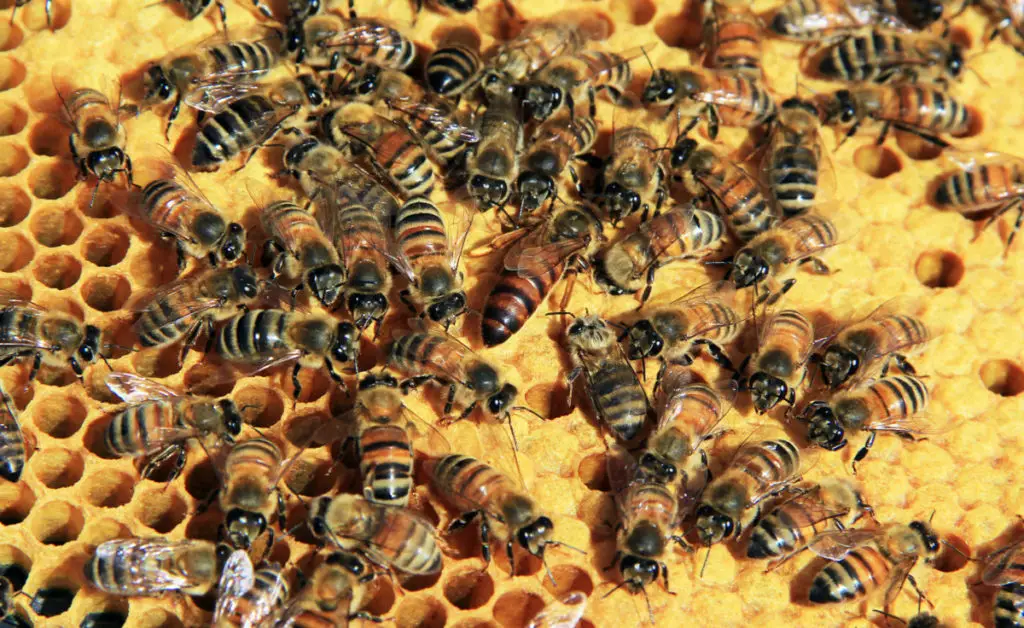
The appearance of the hive is similar in some aspects to a wasp’s nest. It contains hexagonal cells that house the larvae, eggs, and food as well. Beehives have only one entrance.
A beehive with healthy larvae is typically pearly white in color. It is not uncommon for these bees to make their home in a dwelling previously housed by a small animal.
For a detailed look at what beehives are made of check out this article, What Is A Beehive Made Of?
Wasp Nest Vs Bee Nest: Locations And Habitats
Wasp Nest
In comparison to bees, wasps are more adventurous and exploratory when it comes to their habitat. They are not afraid of building nests on human dwellings. Therefore is common to find wasp nests in both urban and suburban areas as well as in meadows, woodlands, and orchards. They build their nests dangling from ceilings, wooden beams, and roofs.
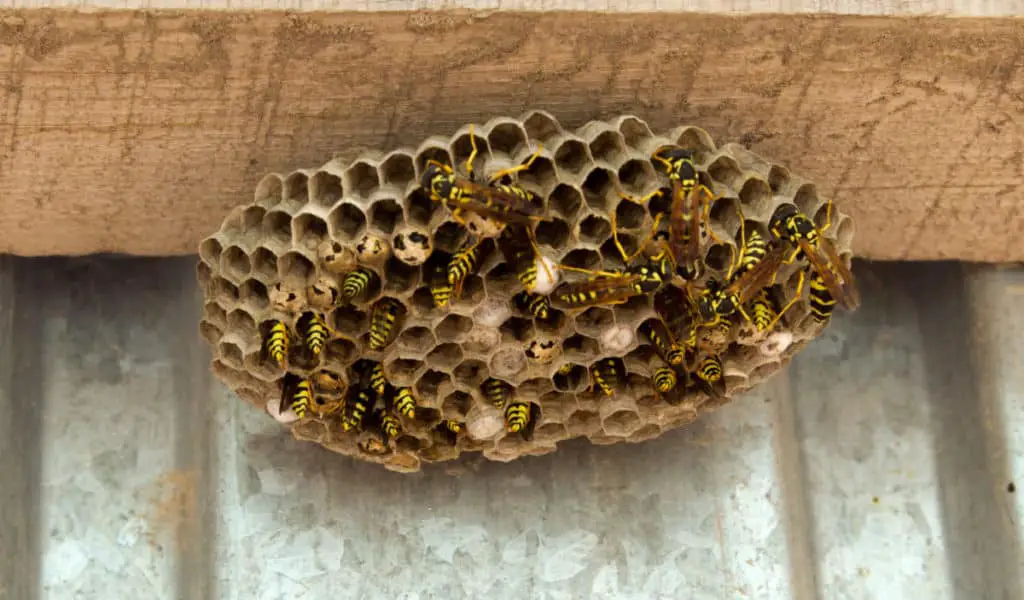
Hornets and yellowjackets are eusocial species of wasps meaning that they live together in one nest. This nest features non-reproducing worker wasps and the queen mother that lays eggs. However, most wasps are solitary in nature. That means there is one female capable of reproducing eggs that live independently.
If you are interested we have written two articles comparing hornet and yellowjackets to wasps. These article links are below:
Yellowjackets are also ground wasps meaning they build their nests in the ground. They are known as social ground wasps. Digger wasps like the Cicada killer wasps are solitary ground wasps meaning the female lives and breeds independently and finds prey to feed to her offspring. They build their nests below the ground.
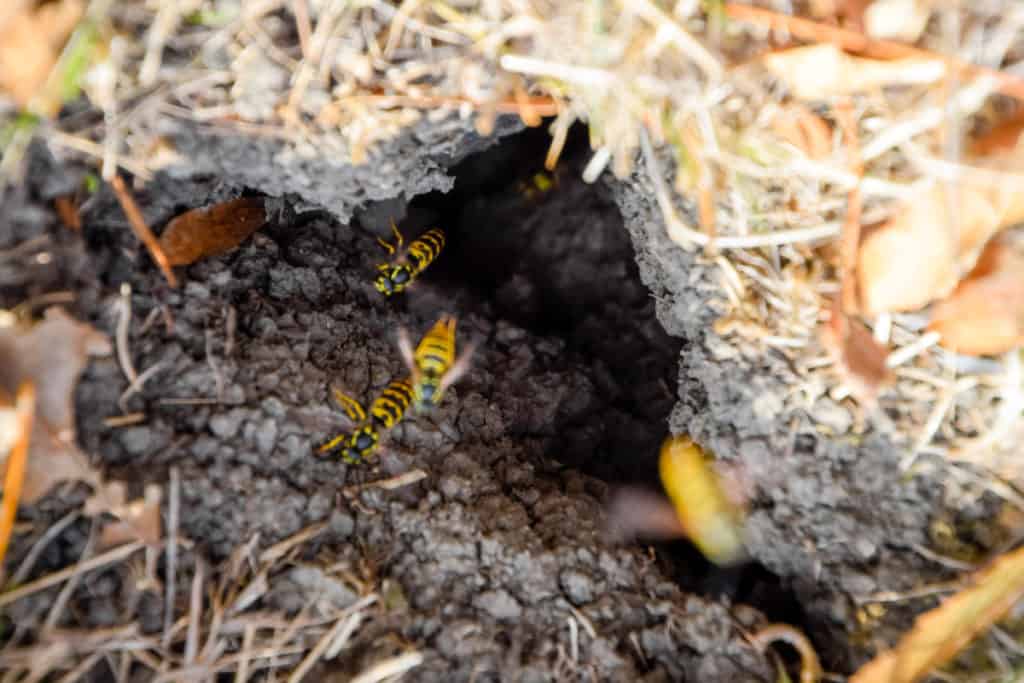
Wasps find it difficult to fly in temperatures below 55 degrees Fahrenheit so many of them die at the onset of winter when the temperatures begin to plummet. In the fall, all wasps die except the new queens that hibernate to emerge in spring.
Vespid wasps, also known as paper wasps, typically build small paper-like nests on the roof of the house. The ground wasps build theirs in animal burrows, fallen tree trunks, piles of debris, crawl spaces, attics, and wall voids. Wasps occur all over the world and in North America. You will encounter vespid wasps like yellowjackets, hornets, and paper wasps across many different states.
Bee Nest (Beehive)
Eusocial bees naturally seek out a cavity that has the capacity to hold 15 to 100 liters of weight. That is a suitable location to build their hive. The busy insects live in large colonies so they need a home that can hold their entire population, their offspring, and, of course, the honey. They also have several generations living together in socially complex societies.
Species of eusocial bees include honey bees and bumblebees. They build their homes away from the elements which is the reason why you can find their hives inside tree cavities. Sometimes, however, bees build their hives in the open on a thick tree branch that can adequately hold a heavyweight.
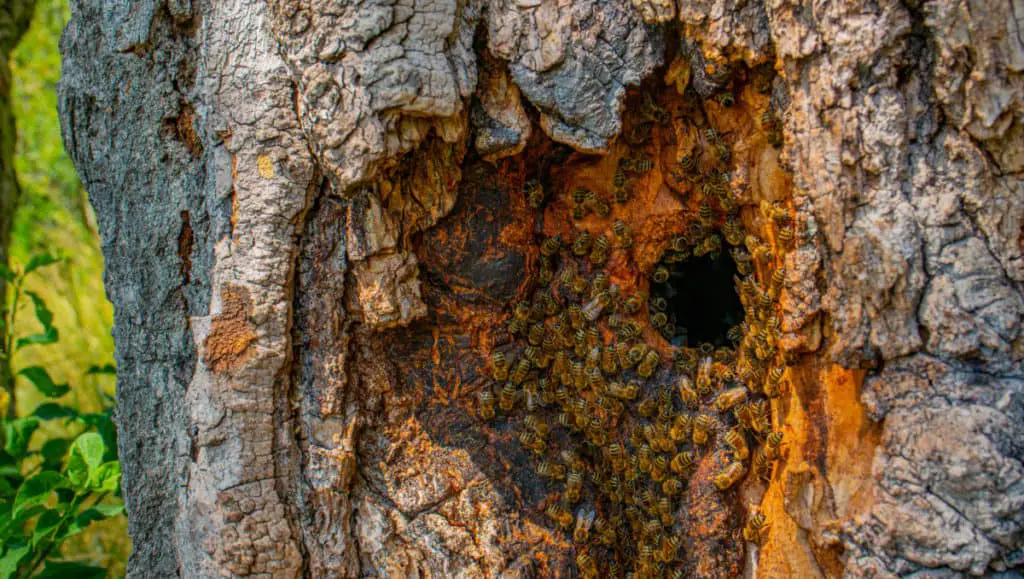
Solitary bees like miner bees build their homes in the ground earning the name ground-nesting bees. These species of bees create underground galleries in which the queen lives alone with her young.
Several queen bees may nest in the same area. These dwellings are not considered typical hives. Ground-nesting bees burrow into dry soil and to keep predators away, they build a canopy of wax over the nest.
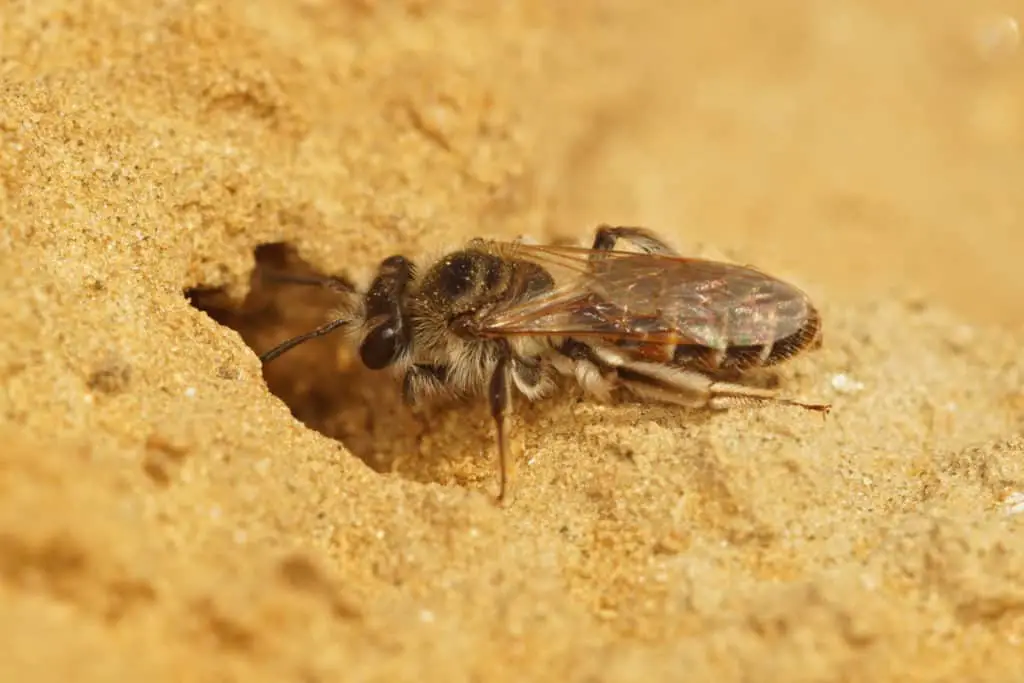
While bees may build a hive in your attic or unused woodshed but they typically prefer to build in remote places away from human interference. That is why even the hives in the open tend to be high up on the tree. Bees are incredibly smart.
When you see them in your garden it is because they are looking for nectar and pollen from the flowers. Bees can travel up to to 5 km from their hive on these foraging trips. The honeybees flying ability is amazing being able to carry almost their body weight in nectar and pollen.
The buzzing critters survive best in tropical climates and heavily forested areas. But they can also thrive in orchards, woodlands, and meadows as long as there are plenty of flowering plants. Bees hibernate in the winter inside their hives. They maintain a temperature of 81 degrees Fahrenheit inside the hive and 48 degrees Fahrenheit on the outside.
Bees can be found in Africa, Europe, Asia, Australia, and America. In North America, they are strewn all over the country depending on the species.
Wasp Nest Vs Bee Nest: Size
Wasp Nest
At the onset, the wasp nest is usually very small. It features as few as three to five cells. As the queen begins to build it more, it grows into the size of a walnut. The process of building the nest begins in spring when the new female settles down to start her colony. By the peak of summer, the size could be that of a football.
A wasp’s nest ultimately holds at least three to six thousand members of the colony but there have been few discovered containing up to 10,000 members. Such massive nests are a rare occurrence.
One species that make large nests is the Mexican Honey Wasp and, yep, you guessed it, they do make honey. If you are interested we have written an entire article about them called, Do Wasps Make Honey? (Hint: One Species Does)
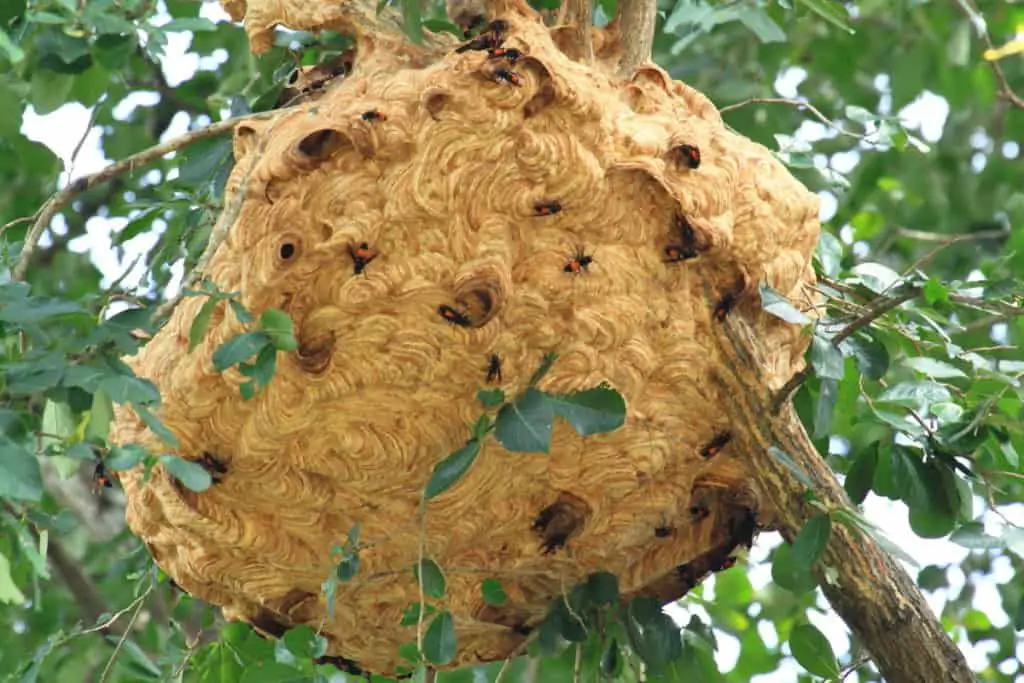
Paper wasps produce only a dozen workers so their nests tend to be very small. Larger wasps have more workers so their nests are bigger.
Bee Nest (Beehive)
An average-sized beehive can host as many as 30,000 bees. However, the larger the hive the greater chance of having an even higher population of bees. The colony consists of one egg-laying queen, over 20,000 female worker bees, and hundreds of male drones. In some hives, the female workers can be as many as 80,000. There are also larvae and eggs still in the process of growing.
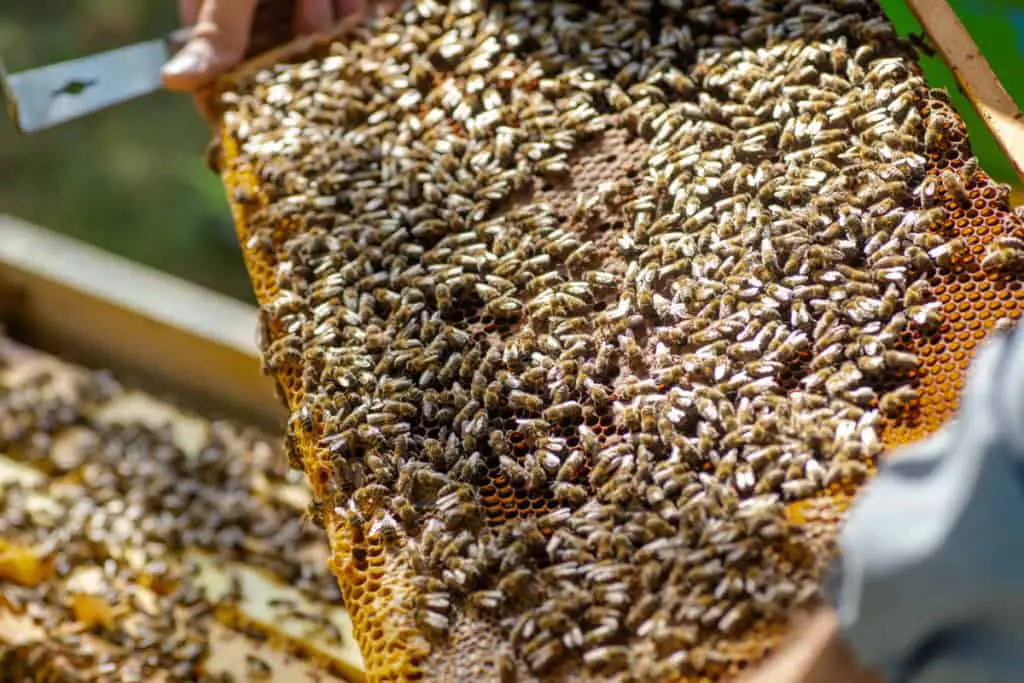
Hives have the capability of expanding to such massive proportions as bees do not die off during winter, they hibernate. This allows them to continue growing in numbers as they have stored enough food to get them through the winter and the female is still laying more eggs.
The intricate structure of a beehive consists of (in order).
- The entrance
- Entrance soothing
- Peripheral gallery
- Drone comb
- Brood nest
- Pollen storage areas
- Honey storage area
The size of the beehive is larger than a wasp’s nest. A ten-month-old hive that holds a population of 60,000 bees and can weigh up to 50kgs.
Hives that have encountered no human interruption and been in existence for years have been found to be as tall as 20 feet and house 500,000 bees. Beehives grow up to a foot and a half each year.
Wasp Nest Vs Bee Nest: Level Of Activity
Wasp Nest
Wasp nests are not active all year round. In fact, it is common to find an abandoned vespid wasp nest on the wooden beams outside your house during fall and winter. A wasp’s year begins in spring when they come out of hibernation and begin to build new nests. Their activity levels peak as the temperature grows warmer into the summer.
They continue to be active through early into mid-fall. In late fall, their activity levels begin to decrease as the temperatures start to dip. By early winter, most wasps have died, and the new females have begun to hibernate to survive the winter.
When hibernating, the females tuck their wings and antennae under their bodies. They use their hind legs to anchor themselves in place throughout the winter. Some hibernating queens die over the winter when they fall prey to predators that find their hiding spot.
Wasps do not reuse nests but if the environment around is favorable new nests will be built every year.
If you are interested we talk more about wasp hibernation in another article we have written called, Do Wasps Sleep At Night?
Bee Nest (Beehive)
Bees can survive the winter because they form a winter cluster. The winter cluster helps with thermoregulation in the hive as the temperatures drop. When the temperatures drop to 57 degrees Fahrenheit, the bees form a cluster, which is a well-defined ball made up of the bees inside the hive.
They form the cluster around the brood tightening it to preserve and generate heat. As the temperature cools, the cluster contracts so that there is less likelihood of the cold seeping in.
Within the cluster, the bees contract and relax their powerful wing muscles to generate metabolic heat. Keep in mind the honey storage area is close to the brood nest. That is because during winter the bees need to be close to the brood and also, have food (honey). If the food is not near, they will die of starvation because they cannot leave the tightly knit winter cluster to go eat the honey.
If you are a beekeeper it is possible to reuse a hive to restart a new colony after the older bees have died off. Feral or traditional beehives can be reused in the future as long as they maintain the requirements of the bees in holding their weight and building needs.
Experienced beekeepers will also capture swarms of bees or even remove bees that have made hives in wall cavities of buildings. It is actually a very interesting process. If you would like to know more check out this article we have written, Bee Removal. How It’s Done and Who Can Do It For You.
Wasp Nest | Bee Nest (Beehive) |
The biggest wasp nest is the size of a football | Beehives are larger in size |
The nest has more than one entrance | The hive has only one entrance |
The chambers are small in size | A hive has larger chambers |
A wasp’s nest is made of chewed wood fiber | Hives are made from beeswax |
Wasp Nest Vs Bee Nest: Which Nests Should Be Avoided?
All nests should be avoided except those of stingless bees. There is a variety of stingless honey bees whose honey is considered medicinal. Also, ground-nesting bees do not sting because they do not have honey to protect. However, bumblebees and carpenter bees have stingers on their females. Although both species are not aggressive, they will sting if tampered with.
Wasps are typically cantankerous and will sting you as soon as they feel threatened. Wasps have smooth stingers that do not break off like those of bees so they can sting you repeatedly and their sting is very painful. During the sting, the wasp imparts its venom into your body which causes irritation and pain.
To a wasp, your presence is a threat to their home and colony. You may be innocently passing by but they perceive you as a threat and act defensively.
Bees also sting in self-defense. However, they can also sting if they are confused or if stepped on. Queen bees have the capacity to sting you multiple times without dying. That is because their stinger doesn’t have a barb so it does not get stuck in your skin when they pull away. This is also the case with the carpenter bees and bumblebees.
Do you know that bumblebees are not particularly aggressive and it is possible to pet one? Check out this article to find out how Can You REALLY Pet A Bumblebee?
Honey bees die after stinging. Honey worker bees leave their venom sack and stinger in you when they sting you so the venom continues to enter your skin even after they are dead.
They die because their stinger is attached to their thorax. The stinger has a barb that remains in your skin so when they pull away, their abdomen including the digestive tract detaches from their body, and you are left with the barb in your skin.
Ground wasps with nests in high traffic areas can get agitated by the sounds and disturbance and sting you. Ground nesting bees only sting under extreme provocation.
The Wrap Up
Although these insects have a close resemblance and habits, their living quarters are distinct. Bees are pollinators, yet they love to live away from human beings, while wasps are not and they don’t mind living in close proximity to man. Maybe bees do their best work away from our prying eyes because they know they have a prized possession: Honey!
If you like this style of article that compares different bugs then check out some of the others we have written:
Carpenter Bees Vs Bumblebees Vs Honey Bees
Praying Mantis Vs Stick Bug. Are They The Same Thing?
Clover Mites Vs Spider Mites: What is the Difference?
Clover Mites Vs Chiggers – Are They The Same Thing?
Sources
https://www.dkgpestcontrol.co.uk/inside-a-wasps-nest-look-like/4594293447
https://www.catseyepest.com/difference-between-bees-wasps
https://whatbugisthat.com/how-do-bees-survive-the-winter/
https://sciencing.com/build-mason-bee-house-5872632.html
https://www.trulynolen.ca/how-does-cold-weather-affect-wasps/
https://www.hastings.gov.uk/environmentalhealth/pestcontrol/wasps/
https://www.wasp-removal.com/wasp-lifecycle.php
https://entomology.ca.uky.edu/ef611
https://entomology.ca.uky.edu/ef004
https://whatbugisthat.com/ouch-can-a-bee-sting-another-bee/
